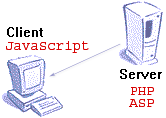When everything is online today, internet or web needs no
introduction. Every business, whether big or small has a website to showcase its
products & services to customers across the globe. Not just companies, TV channels, celebrities,
political parties, and educators, everyone has a website since nobody wants to
be left out from the global exposure that the internet offers. Who makes them,
who is responsible for converting data in the form of websites, the answer is
Web Developers. A web developer is a person who creates or develops a website
and is responsible for its maintenance also. They are the people who make the
web run. A web
developer is a Programmer who specializes in, or is specifically engaged in, the
development of World Wide Web applications,
or distributed network applications that are run over HTTP from a web
server to a web browser.
What does a web
developer do?
With reference to a website, we can say ‘Everything’. A web
developer’s main task it to create a website as per the client’s requirement,
publish it on the web and see that it runs smoothly. A web developer is also responsible for
modifying or upgrading the contents and features of the website as the client desires. A web developer’s task can be broadly discussed as
- Understanding the requirement: The first and foremost task of a developer is to understand what the client needs. He/she must be fully aware of what’s expected of him/her. For example, if the client needs a social networking website, the developer must check whether the site will have the options of uploading videos and images, chat options, video conferencing etc. if the developers fails to understand the features, the website will not work as desired.
- Select technology: Once the requirement is understood, the developer selects the programming languages, database applications and other required technologies to build the website. The selection varies from person to person as everyone has different set of skills and programming background.
- Develop the website: This is the most important task of a web developer – developing or creating a website. The development of the website must be strictly according to the requirements mentioned by the client in the first phase of the process. Creating a website is somewhat similar to creating software, with the only exception is that software’s are meant to run on a standalone system, whereas a website is placed on a server and accessed by millions of users through the internet. Therefore, the responsibility of a developer is not only to create a website and host it over a web server but also to see that the sites functions properly when the web traffic increases. The website should not only be functional but also attractive and fast at the same time.
- Hosting and maintenance: Once the site is finished, it must be deployed on web server so that it can be accessed by web users across the globe, this is called ‘Web Hosting’. The developer must choose a web hosting company that can support all the features present in the website. Changing contents from time to time, checking missing links and other errors are also part of web developer’s duties.
How
to be a web developer
To be a web developer, you must have keen
interest in programming and internet. A web developer must possess the
following skills :
- HTML : Hypertext Markup Language is the language of the web. The core of all the websites is HTML. HTML is not exactly a programming language like C or C++ but rather a ‘markup language’. It is used to set the layout, colors, fonts and the basic appearance of a website. Although there are many WSYWIG software’s like Microsoft Expression Web, Dreamweaver and Visual Studio that can automatically generate HTML code, knowledge of HTML is definitely a must have skill.
- Scripting Languages: Since HTML is not a programming language, any programming related task like decision making, performing calculations, loops cannot be applied in HTML. Scripting languages are those languages that can be embedded in HTML to make a static HTML page dynamic. There are two main categories of a scripting languages:

Client
Side Scripting : When a client requests for a web page from a web server, the server
sends the HTML code of the page to the client. The browser of the client system
reads the HTML code and displays it on the screen. Client side refers to operations that are performed by
the client in a client–server relationship in a computer network. Typically, a client
is a computer application, such
as a web browser, that runs on a user's local computer or workstation and connects to a server as necessary. Popular Client Side
Scripting Languages are VBScript and JavaScript.

Server Side Scripting: Server side refers to operations that are performed by the server in a client–server relationship in computer networking. Typically, a server is a software program, such as a web server, that runs on a remote server. Operations may be performed server-side because they require access to information or functionality that is not available on the client, or require typical behavior that is unreliable when it is done client-side. ASP.Net, PHP and JSP are the main server side scripting languages.
Database:
A website needs to store the data entered by the user, for example an ecommerce
site must store the information regarding the product chosen by the user, its
price and the billing details of the purchase made, similarly a banking website
needs to store the account details of a customer. All such data is stored in a
database application like Oracle, SQL Server or MySQL. A developer must know
how to handle a database application with the help of Structured Query Language
(SQL). The typical functions are how to insert data, update changes, and delete
rows from a table.
XML : Extensible Markup Language (XML) is a markup language that defines a set of rules for encoding documents in a format that is both human-readable and machine-readable. XML has come into common use for the interchange of data over the Internet. XML is easy to learn because you are in control of the layout and structure of the page. Page authors develop their own element names. This means there is no limit to the number of tags one can use on an XML document.
XML : Extensible Markup Language (XML) is a markup language that defines a set of rules for encoding documents in a format that is both human-readable and machine-readable. XML has come into common use for the interchange of data over the Internet. XML is easy to learn because you are in control of the layout and structure of the page. Page authors develop their own element names. This means there is no limit to the number of tags one can use on an XML document.
Difference between a
web developer and a web designer
 While having a discussion on web
developer, we must know that a web developer is different from a web designer.
A web developer is mainly a person who specializes in the coding part of a
website. He/she is a programmer that knows how to make a website functional by
integrating various technologies as mentioned above. A web designer on the
other hand is a person whose main task is to make a website look attractive to
the viewer. A designer uses images,
colors, fonts, animations to make the site appealing. He/she
creates and arranges the pages that make up a website. They often have to
balance how a page looks versus how a web page functions, which can involve
some compromises. If you are a programmer at heart, web development is where
you should look at.
While having a discussion on web
developer, we must know that a web developer is different from a web designer.
A web developer is mainly a person who specializes in the coding part of a
website. He/she is a programmer that knows how to make a website functional by
integrating various technologies as mentioned above. A web designer on the
other hand is a person whose main task is to make a website look attractive to
the viewer. A designer uses images,
colors, fonts, animations to make the site appealing. He/she
creates and arranges the pages that make up a website. They often have to
balance how a page looks versus how a web page functions, which can involve
some compromises. If you are a programmer at heart, web development is where
you should look at.
Courses : To become a web
developer, you can join any web development course that teaches you the above
mentioned technologies. There is no formal degree available in this field
therefore you have to get the required skills by learning these skills as much
as you can. The best practice for you will be to develop a test web site that
includes all the technologies that you have learnt. It is recommended that
before joining such a course, you should check whether it includes the
knowledge of the web hosting process. If the course covers SEO (Search Engine
Optimization) it will be icing on cake.
Institutes:Leading
institutes for a course in web development are Aptech, NIIT, Arena Multimedia
etc. The information regarding the courses offered by them can be obtained from
their respective websites.
Fees: Fees of a course in
web development can range between 5000 to 35000 depending on the course
contents, level of study and the city where you pursue the course from.
Carrer Options:A skilled Web developer can seek a career in
companies offering web solutions or in any company that has a website. You can
also opt for developing websites as a freelancer using your contacts. A freelancer
gets the order and develops the website on his own. There are many websites
that offer web development jobs online also. As a freelancer you can register
yourself in such site and search for online projects.
Salary: The salary of a web developer can be Rs. 10000/- per month
to start with. As the skills and experience grows a web developer can expect a
salary within the bracket of Rs. 20000 to Rs. 40000. As far as a freelancer is concerned,
he/she can quote the price of a website according to number of pages and time
involved.










